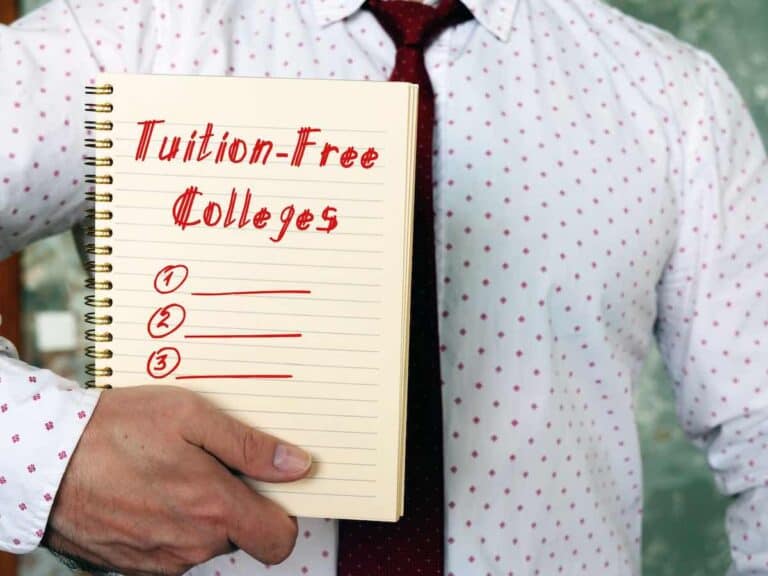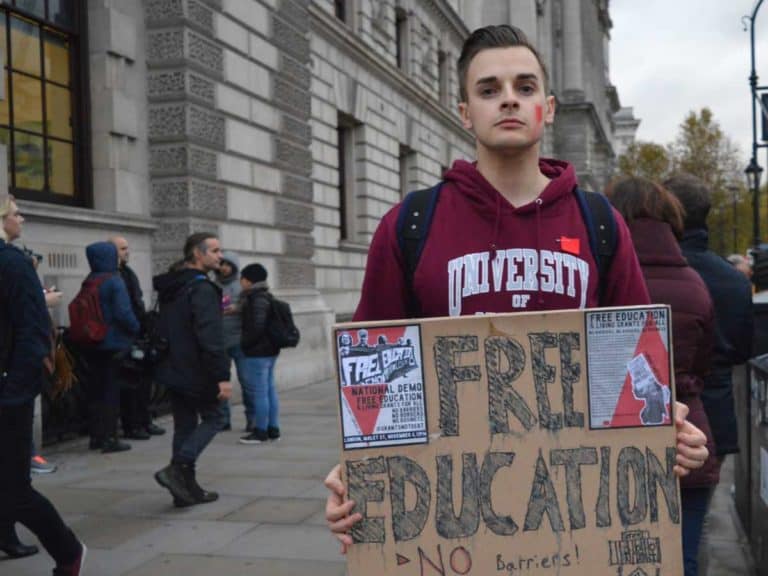Free College: Surprising Stats That Will Make You Rethink Education
Free college allows students to forget about tuition, thus allowing them to focus more on taking care of other postsecondary education-related expenditures and working on their undergraduate degrees.
If you are planning on taking advantage of such a kind of perk, it’s important to know the numbers.
How many degree-seeking students will you have to enroll with at a free college?
Will attending college tuition-free increase your chances of staying in school as well as graduating in 4 or 6 years?
Can free college make you a more successful undergraduate degree-holding career person?
Do tuition-free programs help or ruin the nation’s economy?
With so many questions to ask and very little time before you start applying to colleges, it’s important to know the hard facts so that you can make a more informed decision as far as free higher education goes.
Does Free College Increase Enrollment?
There are many things that can intimidate high schoolers from attending college eventually.
Some of them doubt the value of a college education these days given the fact that many jobs do not require a bachelor’s degree. Others fear that attending college will disrupt their livelihoods.
But perhaps nothing can make college applications more intimidating than the steep cost.
According to a report by Intelligent, which is a Seattle, Washington-based online magazine that provides research to assist college-bound students to make informed decisions, up to 34% of students didn’t go to college because they couldn’t afford it.
On the flip side, the majority of graduating high schoolers apply to institutions with low sticker prices.
With tuition making up about 53.5% of all college costs, says the Education Data Initiative, a steep figure can certainly make college applications daunting, especially to students from low-income backgrounds.
Keeping tuition costs low or even free, needless to say, can cause college applications to soar.
For example, at the University of Michigan, the number of students who applied increased by 68% as a result of a free tuition program. The study, by the way, was conducted by the National Bureau of Economic Research (NBER).
The same study added that free tuition, on the other hand, caused a 28% increase in the number of applications to some of the most selective institutions of higher education in the US.
It’s important to point out that the sample group consisted of high-performing, low-income students.
Read More: Reasons Why College Should Not be Free and Reasons Why It Should
Does Free College Increase Enrollment?
A report by New America, a Washington DC-based think tank, said that states can increase enrollment rates by offering free tuition. True enough, the introduction of the so-called Tennessee Promise has led to an increase of applications to community colleges in Tennessee by about 24.7%.
Tuition — in many instances, it’s the only thing that’s keeping some students from enrolling.
According to the National Center for Education Statistics (NCES), the average tuition was higher in the academic year 2020 to 2021 than in the academic year 2010 to 2011 for first-time, first-year undergraduate students.
The increase was about 10% at public 4-year institutions. Meanwhile, it was around 19% at private non-profit colleges and universities.
Interestingly, average tuition increased by only about 1% from the academic year 2010 to 2011 to the academic year 2020 to 2021 at private for-profit degree-granting schools.
On the other hand, the increase was 9% at public 2-year institutions and 18% at their private counterparts.
A study published by the American Educational Research Association (AERA) said that 33 public community colleges in the US saw large increases in enrollment among first-time, full-time students as a result of free tuition.
Needless to say, many of the students that flocked to community colleges after the introduction of free-tuition programs were from low-income backgrounds.
However, the study added that it also boosted enrollment rates among underrepresented and minority groups, including Blacks, Hispanics and even females.
To have a much better idea, here are the increases in enrollment in community colleges:
- Black males (47%)
- Black females (51%)
- Hispanic males (40%)
- Hispanic females (52%)
Unfortunately, on average, free-tuition programs did very little to no boost in the enrollment rates for other groups such as Asians, Hawaiians and Pacific Islanders — males and females alike.
Free College And Retention Rate
If students are happy with the academics as well as support and services they are getting from the institutions of higher education they are attending, they are more likely to return and enroll in them the following year.
Retention rate — it’s the term used to refer to the percentage of students who return to the same school.
There are many things that can cause a college or university’s retention rate to drop. Dissatisfaction with anything from the program, competence of the professors, teaching methods, facilities and student support can discourage any attendees from going back to the same institution and entice them to continue college elsewhere.
And just like what was stated above, the inability of students to pay for their undergraduate education can have a massive impact on an institution’s retention rate.
True enough, according to numbers coming from some free-tuition community colleges themselves, eliminating tuition, which takes up much of the bulk of the overall cost of higher education, can make it so much easier for low-income students to stay in school until such time that they earn their degrees.
According to a report by The Providence Journal, the Community College of Rhode Island experienced an 83% increase in retention rate after providing tuition-free programs to full-time students.
On the other hand, in Tennessee, the retention rate increase among community colleges was 79%.
Allan Hancock College, a 2-year institution that’s part of the California Community Colleges System, meanwhile, enjoyed a 66% retention rate — 2 out of 3 students in 2018 returned for 2019.
To compare, the retention rate for other community colleges in a nearby district was only 52%.
Free College and Graduation Rates
Needless to say, to see an increase in the number of degree-holders, the number of college attendees must rise.
Considering all the figures mentioned thus far establishes the fact that tuition-free programs can boost not only the number of students applying to colleges but also the number of those actually enrolling.
Before anything else, it’s important to note that not everyone who enters college finishes college. There are many reasons why some undergraduates fail to stay around long enough for them to get their hands on a bachelor’s degree.
Some of them simply don’t have time for college due to other commitments, while others get academic disqualification.
But according to the National Student Clearinghouse Research Center (NSCRC), the primary reason why some students do not graduate is that the cost of education is simply too high for them.
Among those who fail to finish college, students from low-income backgrounds simply drop out.
The NCES says that, in 2020, the average 6-year graduation rate for first-time, first-year students in the US was 64% — the rate of students who enrolled in 4-year institutions in 2014 who graduated in 2020 in the same colleges.
The number of graduates 6 years after initial enrollment, of course, can vary from school to school.
Check out the following 6-year graduation rates at various types of institutions in 2020:
- Public institutions (63%)
- Private non-profit institutions (68%)
- Private for-profit institutions (29%)
According to the NCES, the graduation rates for females in the same year are higher than for males — 67% vs. 60%. The trend remained true for both public and private non-profit colleges and universities.
On the other hand, at private for-profit institutions, the graduation rate for males is higher — 31% vs. 28%.
Mentioned earlier was the fact that community colleges with free tuition would enjoy only a small increase in the number of graduates.
However, the same study proposed that an increase in annual tuition subsidy would cause an increase in the graduation rate of up to 30%, which is over 86% higher than before.
Tuition-Free Colleges in the US
There are a total of 20 states in the US that offer tuition-free community colleges. Other than community colleges, there are also some public and private 4-year institutions with free tuition programs for students who meet eligibility requirements, including meeting a certain income level.
In many instances, being from a low-income background and the rising college costs should not keep a degree-seeking student from applying to American degree-granting schools.
That’s because the government and many institutions take steps in making higher education more accessible.
Case in point: tuition-free programs.
But while they allow students to take advantage of affordable college that entails shelling out zero dollars for tuition, these programs do not necessarily make college entirely cost-free — typically, students will still have to spend money on other associated costs such as room and board and transportation.
As mentioned above, 20% of all US states offer community colleges with free tuition. And they are:
- Arkansas
- California
- Connecticut
- Delaware
- Hawaii
- Indiana
- Kentucky
- Louisiana
- Maryland
- Massachusetts
- Missouri
- Montana
- New York
- Nevada
- Oklahoma
- Oregon
- Rhode Island
- Tennessee
- Virginia
- Washington
There are a couple of ways through which some community colleges allow undergraduate students to attend cost-free. And they are first-dollar programs and last-dollar programs.
Basically, first-dollar programs cover full tuition without considering any financial aid students may receive. Thanks to them, the overall cost of college can be reduced as financial aid awards can be put toward other college costs.
With or without financial aid, first-dollar programs also tend to cover a wider range of college-related expenditures.
On the other hand, last-dollar programs do not take care of full tuition. What they do, instead, is cover any remaining tuition after students receive financial aid.
Students from low-income families need not stick to community colleges just to enjoy tuition-free postsecondary education.
That’s because there are also numerous public and private 4-year institutions in the land — including some of the most prestigious ones — that allow students to attend without paying tuition.
However, as expected, there are eligibility requirements to meet such as:
- Being a state resident
- Coming from a family whose annual income falls under a certain threshold
- Working for a certain number of hours at the school
- Commit to some type of service after graduation
Read More: 36 Colleges That Offer Free Tuition for Low-Income Students
Free College and Economy
The College for All Act, which aims to make tuition free at all public 2- and 4-year institutions and tribal colleges, would cost the government $41 billion yearly.
However, the said increase in annual expenditure would allow students to graduate without debt, which could stimulate the economy.
Despite what it’s called, free college isn’t absolutely free.
Students who are eligible for free-tuition programs will still have to shoulder other college-related stuff, which can range anywhere from school supplies, room and board to personal expenditures.
While it’s true that undergraduate students do not pay tuition as they work on their respective degrees, the taxpayers do.
As a matter of fact, according to the Education Data Initiative, free college can cost, on average, up to 3 times what the local and federal tax dollars, whose primary source is individual income taxes, pay now.
So, in other words, it’s the taxpaying citizens of the US that actually pay for free tuition at public community colleges and 4-year institutions of higher education in the land.
Needless to say, there are negatives to free college — well, at least for people who have to shoulder tuition.
But, ultimately, it’s not just degree-seeking students from low-income backgrounds that will benefit but the economy, too.
Providing individuals access to low-cost or even free education allows them to penetrate higher-paying sectors of the workforce, which requires them to move to a higher income tax bracket.
Just like what was talked about earlier, free college increases the graduation rate. And with the availability of more degree holders seeking employment, more businesses will open to grab the opportunity.
It’s a win-win situation for all parties concerned.
Money-making ventures, for one, can hire only the most qualified individuals, which fosters business growth and success — strong ones pay more taxes that go to essential services such as roads, law enforcement and, of course, school.
High-paying jobs that large companies make available also pave the way for a higher quality of life.
The economy, meanwhile, becomes stronger by means of the provision of locally produced commodities and, of course, as a result of collecting higher tax money from booming businesses.
Can Free College Reduce the Value of a Degree?
By now, we have established the fact that free college can benefit a lot, ranging from low-income students to the nation itself which provides tuition-free programs to eligible students.
Because many would like to take advantage of it, naturally, free colleges could wind up being overpopulated.
True enough, in 1998, the UK stopped offering institutions of higher education that are free to attend — the number of first-time, first-year enrollees rose, the funding remained the same and the quality of education declined.
The attempt of the government to take control of the situation by reducing the acceptance rates at free colleges did very little to none.
It’s as a result of this why, eventually, students at public colleges and universities in the UK were charged modest tuition fees. These days, tuition costs at government-funded schools average £9,250.
Because there are free colleges, there’s no reason for many students from low-income backgrounds to do the math in order to find out how much they will have to pay at private schools after financial aid.
Needless to say, with numerous degree-seeking students wanting to take advantage of free-tuition programs, applications to private institutions may drop.
As a matter of fact, a study conducted by Georgetown University found out that free college would lower the rate of enrollment in private colleges and universities by as much as 15%.
Since there are more students attending college free of charge, each one is likely to be subjected to unfavorable learning conditions and ineffective instructors and teaching methods, thus reducing the value of an undergraduate degree.
An article by FEE Stories says that an increase in college completion may lessen a degree’s purchasing power.
Read Next: How Does Free College Work Outside the US
Disclaimer: The views and opinions expressed in this article are those of the authors and do not necessarily represent those of the College Reality Check.





